Salesforce Integration: The Complete Guide for Business Success
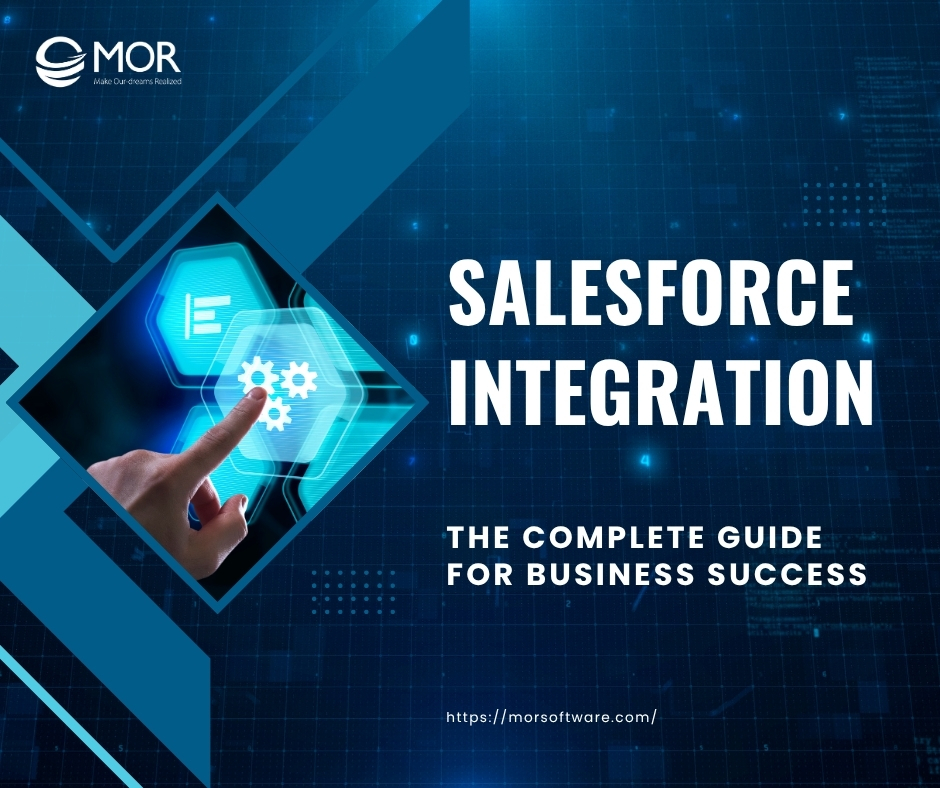
Salesforce isn’t built to live in a silo. If you want data to flow, teams to sync, and operations to move faster, you need Salesforce integration. This MOR Software’s guide will break it all down: what it means, why it matters, and how to do it right.
What Is Salesforce Integration?
Salesforce integration means connecting Salesforce with the other apps, systems, or databases your business uses every day. It lets data move freely between platforms, so you’re not stuck jumping between tabs or copy-pasting records. Everything stays in sync. Everyone stays on the same page.
McKinsey finds that companies that coordinate sales, marketing, and service around shared data pipelines grow revenue 5 to 10% faster than peers.
According to Statista, global revenue in the customer relationship management (CRM) software segment is projected to grow by over $46.5 billion from 2025 to 2030, reaching $145.37 billion, showing why connected platforms matter more each year.
There are several ways to integrate Salesforce, depending on your setup and goals. Many teams use APIs, short for Application Programming Interfaces, to push and pull data between platforms in real time.
Salesforce supports both REST and SOAP APIs, each with its own strengths. REST is lighter and faster for web and mobile apps. SOAP is more structured, often used for secure enterprise-level tasks.
Besides APIs, you’ll find built-in integration tools like Salesforce Connect, AppExchange apps, and third-party middleware platforms. Some of these let you tap into external data sources without storing the data in Salesforce. Others help automate routine workflows between systems like your ERP, CRM, or marketing tools.
Done right, integrating Salesforce turns it into a connected hub, not just for customer data, but for sales, support, inventory, reporting, and more. It helps companies keep data fresh, eliminate manual work, and make better decisions, faster.
No surprise, then, that salesforce crm integration is now one of the most common requests across both IT and operations teams. If your company is still running disconnected systems, you’re falling behind. That’s where strong salesforce integration solutions come in.
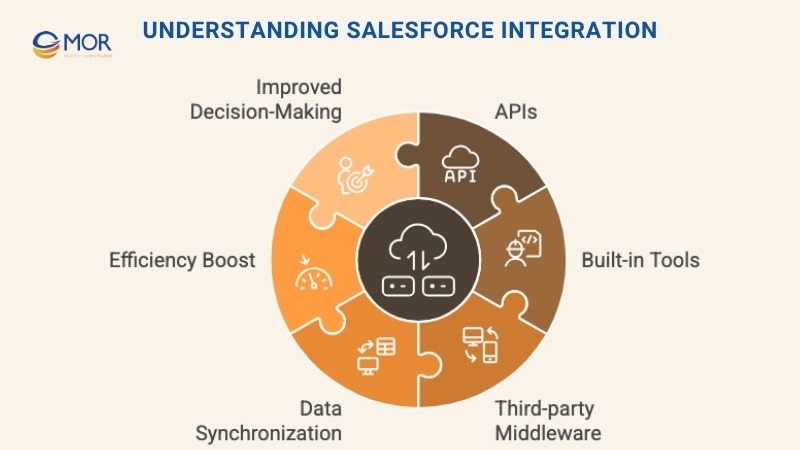
What Is Salesforce Integration?
Why Does Salesforce Integration Matter for Business?
Disconnected tools slow everyone down. Sales can't see what support knows. Marketing sends the wrong email. Inventory's out of sync with demand. You waste time, miss chances, and risk losing customers. That’s why integrating Salesforce isn't just a technical upgrade. It's a business necessity.
Forbes estimates that data silos drain businesses of roughly $3.1 trillion in lost productivity and revenue every year, a cost that robust integrations are designed to eliminate.
When Salesforce talks to your other systems: ERP, eCommerce, data warehouses, or analytics, you get better visibility and faster execution. Teams collaborate instead of guessing. Leaders trust the numbers. Customers get timely updates.
Bloomberg notes that Salesforce itself forecasts up to $38 billion in sales this fiscal year. This shows how mission-critical the platform has become for enterprises worldwide. Whether you're managing global operations or just trying to clean up internal handoffs, integration helps. It removes the friction. And that gives your business room to grow.
This is why more teams are searching for salesforce integration services that fit their unique stack. The goal isn’t just connection. It’s clarity, speed, and control. MOR Software knows what that looks like, and we’ll show you how to get there.
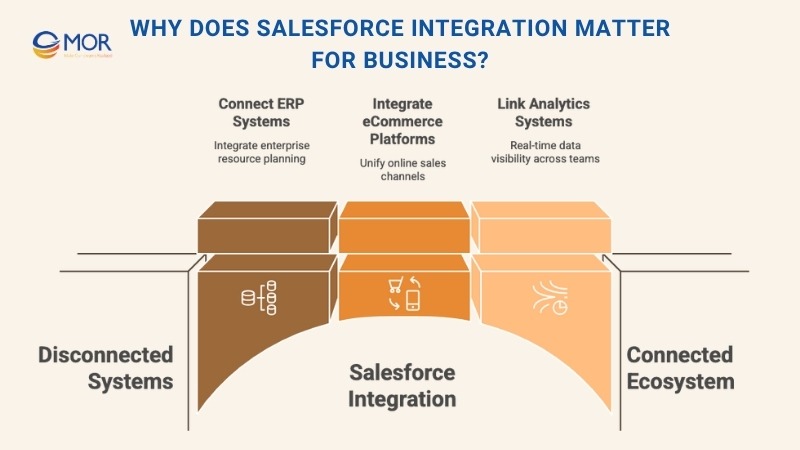
Key Benefits Salesforce Integration for Businesses
Getting Salesforce connected isn’t just about syncing data. It’s about changing how your teams work. Businesses that invest in salesforce integration see measurable improvements in collaboration, decision-making, and speed. We’ll break it down for you.
Unified customer view and improved collaboration
When your CRM talks to everything else like email, chat, billing, support, you finally get the full picture. No more digging through tools to find the latest update. It’s all right there in Salesforce.
Nielsen reports that 64% of consumers actively avoid ads that feel irrelevant. So, a unified profile is now essential for personalisation that keeps audiences engaged.
A salesforce crm integration makes it easier for teams to collaborate. Sales reps see open support tickets. Marketers know which products a customer already bought. Finance gets real-time payment data. Everyone shares one source of truth.
This unified view isn’t just convenient. It’s a game-changer for customer service. You respond faster. You personalize better. And you make decisions based on facts, not guesswork. That’s how salesforce teams integration turns disconnected teams into one smooth unit.
Automated workflows and increased productivity
Nobody likes manual data entry. Or updating the same lead across five systems. That’s where salesforce integration services really shine.
When systems talk to each other, workflows run on autopilot. A new lead from your website can trigger an email sequence, log activity in your CRM, update your marketing dashboard, and assign a rep, all without touching a thing.
A Wall Street Journal survey found that the average knowledge worker now spends 57% of the week in email, chat, or meetings. This means every automated hand-off frees up hours for higher-value work.
You save hours per week. Errors drop. Teams move faster. Even better, automation scales with you. Whether you handle 50 leads a day or 5,000, integrated systems keep up without breaking a sweat.
That’s why companies looking to grow turn to salesforce integrators to map, connect, and automate every step of their pipeline.
Real-time data access and reporting
Slow data is bad data. If your reports are always outdated or pulled manually, you’re behind.
With strong integration for Salesforce, data moves in real time. Orders, contacts, tickets, campaign results. They flow in as they happen. That means dashboards update instantly. Managers get live performance snapshots. Sales reps follow up the same day, not the next week.
A global study cited by Reuters found that two-thirds of professionals already use AI tools daily, and 83% expect measurable business benefits.This raises expectations for instant insights and action.
This isn’t just about speed. Real-time reporting helps you spot problems early and act on trends faster. It also makes audits, compliance checks, and forecasting far more reliable.
Businesses using tools like APIs or ETL platforms as part of their salesforce integration services in USA or globally rely on this constant data sync to stay sharp and competitive.
Enhanced data quality, security, and compliance
Bad data doesn’t just cause confusion. It creates risk. Duplicate records, mismatched fields, missing info, all of it hurts trust and performance.
Sales force integration solves that. When systems align, data stays clean. Updates happen once, everywhere. Validation rules and transformation logic keep formats consistent. You spend less time fixing and more time selling.
Security improves too. Instead of downloading sensitive data, you keep access controlled through platforms like Salesforce Connect or encrypted API calls. You also reduce human error, which is still the top cause of data breaches.
According to the U.S. Government Accountability Office, maintaining just ten critical legacy systems costs $337 million annually, highlighting the hidden risks and expenses of outdated, disconnected infrastructure.
And when you work with certified salesforce integration services India or US-based providers, you can meet global privacy standards without patchwork solutions.
Bottom line? Integration isn’t just about moving data. It’s about moving smart, safe, and secure.
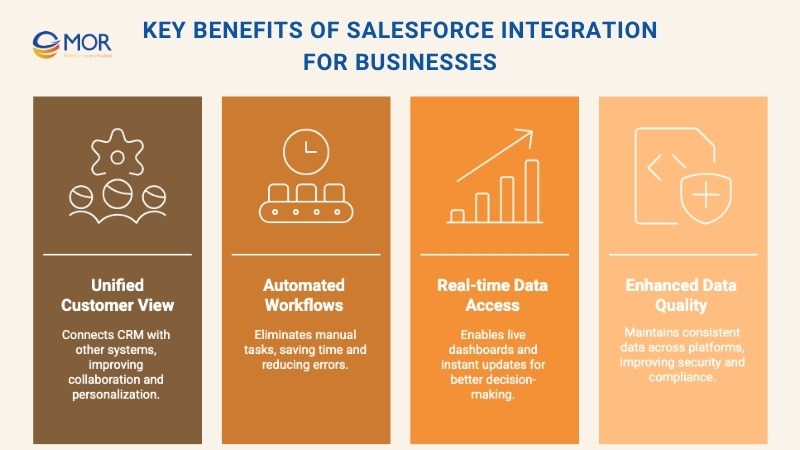
Key Benefits Salesforce Integration for Businesses
TOP 3 Popular Salesforce Integration Methods
You’ve got options when it comes to salesforce integration. But choosing the right method depends on your tech stack, your budget, and how fast you need to move. Let’s look at the top three ways businesses connect Salesforce to the rest of their systems.
Native Integration Tools
Salesforce comes with built-in tools to make integration faster and less technical. TechCrunch highlighted that the AppExchange surpassed 2 million cumulative installs, giving teams a vast plug-and-play ecosystem to accelerate native integrations. If you’re already in the ecosystem and want something lightweight and reliable, start here.
- Salesforce Connect lets you work with data from external systems without importing it into Salesforce. You view and update that data in real time, which helps when dealing with large datasets or platforms with strict storage rules. Think of it as remote control, fast, flexible, and efficient.
- AppExchange, on the other hand, is like a marketplace. It’s packed with ready-made integrations and apps for finance, marketing, support, and more. No coding required. You can install a solution and go live in hours, not weeks.
Native tools are ideal if you need speed, security, and Salesforce-approved solutions. Many companies offering salesforce integration services start with these for quick wins before layering in more complex setups.
API-Based Integrations
If you want full control, APIs are the way to go. Salesforce offers several types, each suited to different jobs. These APIs are the backbone of many salesforce integration solutions today.
- REST API is great for mobile apps and lightweight web services. It uses simple HTTP methods and supports JSON and XML, making it flexible and easy to use.
- SOAP API is more rigid but better suited for enterprise-level needs. It supports more data operations and enforces stronger structure. Many legacy systems still depend on SOAP.
- Bulk API, designed for high-volume data loads like importing millions of records. It handles big jobs without slowing down your system.
- Metadata API helps you manage configuration and customizations across environments. You’ll use it when moving changes from sandbox to production.
- Pub/Sub API lets you stream event data between Salesforce and other apps in near real-time. It supports asynchronous communication and works well for systems that publish or listen for updates on demand.
If you’re integrating with in-house apps or building something custom, APIs give you flexibility and precision. That’s why top salesforce integrators rely on them when off-the-shelf tools don’t cut it.
Middleware and Third-Party Platforms
Sometimes native tools and APIs aren't enough, especially if you're dealing with dozens of systems, legacy software, or unique workflows. That’s where middleware steps in.
- MuleSoft, owned by Salesforce, is one of the most advanced platforms out there. It connects cloud and on-premise systems, handles real-time data, and supports reusable APIs. Big enterprises love it.
- Dell Boomi is another solid option. It’s cloud-native and great for hybrid environments. Boomi’s visual interface makes it easier for teams without heavy development resources to manage integrations.
- Zapier fits smaller businesses or teams that need quick, no-code automation. You can create ‘zaps’ between Salesforce and tools like Gmail, Trello, or Slack with just a few clicks.
- Informatica, known for its data management capabilities, supports complex ETL processes. It’s great for businesses focused on clean, structured, and validated data movement at scale.
These platforms act as a central hub. Instead of managing dozens of one-to-one integrations, you connect everything through one tool. This reduces maintenance, improves visibility, and speeds up development.
Many companies offering salesforce integration services use middleware to handle the mess behind the scenes. It’s the quiet workhorse that keeps your systems running like clockwork.
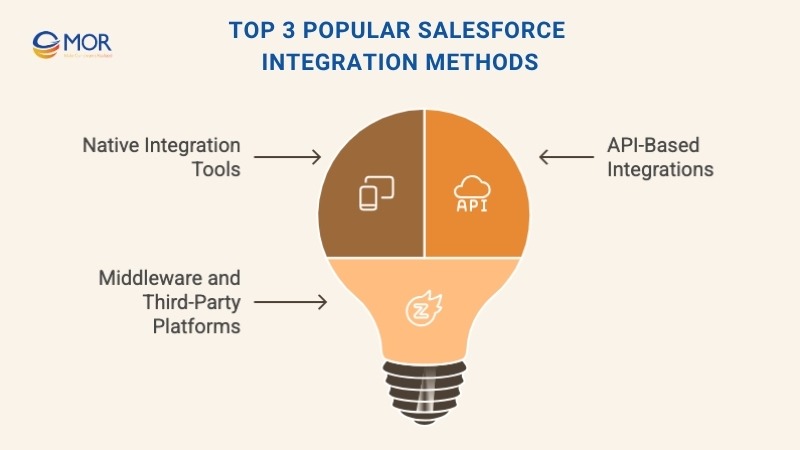
TOP 3 Popular Salesforce Integration Methods
Comparison Table for the TOP 3 Popular Salesforce Integration Methods
Integration Method | Description | Best Use Cases |
| Native Integration Tools | Built-in Salesforce features like Salesforce Connect (real-time external data access) and AppExchange (pre-built integrations). Fast to deploy and low-code. | Quick deployment, Salesforce-centric teams, small to medium businesses needing secure, Salesforce-approved tools |
| API-Based Integrations | REST API (for mobile/web apps), SOAP API (for enterprise systems), Bulk API (large data loads), Metadata API (for configs), and Pub/Sub API (real-time streaming). Ideal for custom setups. | Custom workflows, high-volume data handling, real-time apps, internal app connections |
| Middleware Platforms | MuleSoft (real-time + reusable APIs), Dell Boomi (cloud-native, visual UI), Zapier (no-code for small teams), Informatica (ETL, data quality). Acts as a hub for all integrations. | Large or hybrid systems, legacy app integration, companies needing data governance, teams without heavy dev resources |
Common Salesforce Integration Use Cases You Should Know
Real-world results matter more than theory. And salesforce integration proves its value best through use cases. From syncing massive datasets to automating lead handoffs, these examples show what’s possible when Salesforce connects with your business tools.
Connecting Salesforce with Data Warehouses
Data warehouses are where your historical, transactional, and behavioral data lives. But without connecting them to Salesforce, you're leaving insights on the table.
IDC expects global digital-transformation spending to approach $4 trillion by 2027, much of it driven by projects that connect analytics layers like warehouses to frontline apps such as Salesforce.
- BigQuery, for instance. When integrated with Salesforce, it helps marketing teams combine campaign data with CRM activity. That means smarter segmentation, real-time personalization, and performance insights you can actually act on.
- Snowflake is often used in finance. Paired with Salesforce, it merges customer interaction data with financial transactions. This helps assess credit risk, monitor compliance, and build profitability models without switching tools.
- Redshift shines in operations-heavy environments. Businesses use it with Salesforce to connect order management and inventory data. Think demand forecasting, delivery tracking, and real-time stock visibility, all accessible through your CRM.
- Databricks. In healthcare or data science-driven industries, Databricks adds advanced analytics and machine learning capabilities to Salesforce data. You can automate care recommendations, predict churn, or identify new revenue opportunities.
These aren’t just IT wins. These integrations shape strategy. Businesses offering salesforce integration services often start with the data warehouse layer because it sets the foundation for smarter decisions across the board.
Integrating Salesforce with Business Platforms
Salesforce works best when it’s tightly connected to the platforms your teams use every day, from backend systems to customer-facing tools. This creates a faster, more aligned experience for everyone involved:
- ERP systems like SAP, Oracle, or Microsoft Dynamics help manage inventory, billing, and HR. When integrated, Salesforce gains real-time access to orders, fulfillment status, and invoice history.
- Marketing platforms such as HubSpot, Marketo, or Mailchimp trigger email campaigns or retargeting ads the moment a lead hits “Sales Qualified” in Salesforce. This means better timing and fewer missed opportunities.
- E-commerce platforms like Shopify and Magento sync with Salesforce to share order history, customer behavior, and preferences. That data powers better product recommendations and support.
- Collaboration tools such as Slack or Google Sheets enable live updates. A deal closed in Salesforce can ping a sales channel, or a new contact can auto-populate a shared spreadsheet.
These connections eliminate manual updates, reduce confusion, and keep everyone focused on what matters. Companies searching for the best salesforce integration services know the real win isn’t just syncing systems. It’s making teamwork flow.
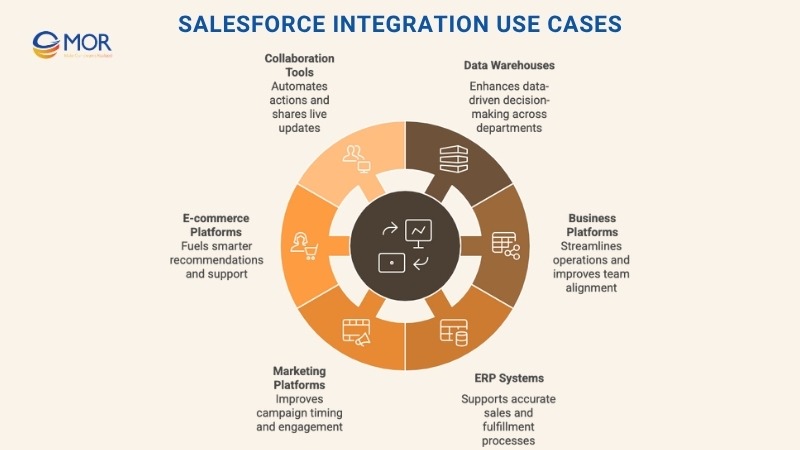
Common Salesforce Integration Use Cases You Should Know
How To Choose the Right Salesforce Integration Strategy?
Picking the right salesforce integration approach isn’t about trends. It’s about fit. What works for a global retailer might stall a small SaaS team. The best way forward is to get clear on your goals, map your systems, and pick tools that work with, not against, your workflows.
You can use this quick checklist to guide your decision:
- Define your business objective: Are you trying to automate a process? Improve reporting? Unify customer records? Your goal shapes your method.
- Know your data volume and frequency: If you move large datasets, look at Bulk API or ETL tools. For real-time updates, consider REST, Pub/Sub, or middleware.
- List the platforms involved: Are you connecting Salesforce to a single app or a dozen systems? Complex ecosystems often need middleware like MuleSoft or Boomi.
- Evaluate internal resources: Do you have in-house developers, or will you rely on a provider? Some salesforce integration services come with prebuilt templates or low-code options for faster deployment.
- Check for out-of-the-box tools: Start with Salesforce Connect, AppExchange, or native APIs. They’re tested, secure, and often faster to launch.
- Factor in long-term maintenance: Who will own the integration? Will it need constant updates as your stack changes?
- Look at compliance and security: Especially for finance, healthcare, or global businesses. Ask if the method supports access control, encryption, and audit trails.
Businesses that work with trusted salesforce integrators often run through this exact process before making a move. A good strategy doesn’t just connect systems. It future proofs how your teams work together.
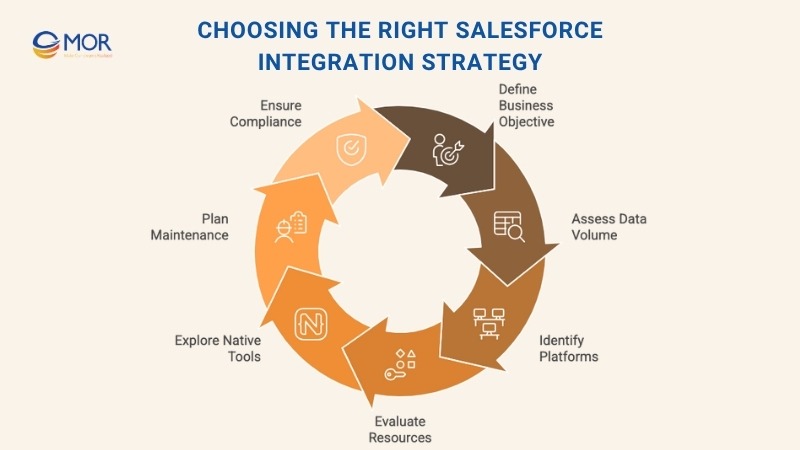
How To Choose the Right Salesforce Integration Strategy?
Salesforce Integration Patterns Explained
Choosing the right salesforce integration pattern can make or break your project. These patterns aren’t one-size-fits-all. They’re playbooks for how data moves between Salesforce and external systems. Let’s break them down.
Request and Reply
This pattern works when Salesforce sends a request and waits for a response, like checking credit status before approving an order. It’s real-time, reliable, and often used for validations or lookup functions.
It’s best when both systems need to talk instantly and the user can’t move forward without an answer. But it does rely on uptime from both ends. If one goes down, the flow breaks.
Fire and Forget
Here, Salesforce sends data but doesn’t wait around for confirmation. Think: logging an event, pushing an update, or sending data to a backup system.
It’s faster and doesn’t block the user. But without a response, you won’t know if the message landed. Use this for low-risk or non-critical updates where speed matters more than feedback.
Batch Data Synchronization
If you move lots of data on a schedule, this is your pattern. It works well for nightly syncs from Salesforce to data warehouses or backups.
The trade-off? It’s not real-time. But it’s reliable, scalable, and less demanding on API limits. Most sfdc integration tools support batch syncing out of the box.
Remote Call-In
External systems can also call into Salesforce. This pattern is useful when third-party apps need to create or update records in your CRM such as a payment processor logging transactions.
It requires secure authentication and usually uses REST or SOAP APIs. Done right, it opens up powerful two-way communication across platforms.
Data Virtualization
This pattern lets you view and work with external data inside Salesforce without actually storing it there. Salesforce Connect is a good example.
It reduces storage usage and keeps external systems as the ‘source of truth.’ Ideal when you need access, not duplication. Especially handy in finance, logistics, and reporting-heavy environments.
Knowing which pattern fits your workflow means smoother builds, fewer surprises, and better performance. And when in doubt, a seasoned salesforce integration services provider can help map it out.
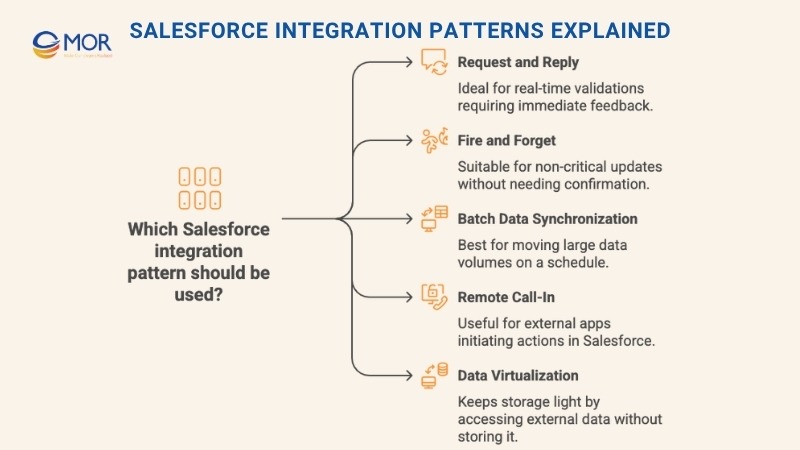
Salesforce Integration Patterns Explained
Best Practices for Successful Salesforce Integration
Even the best tools fall short without a solid game plan. Whether you're managing the project in-house or working with external salesforce integration services, following proven best practices keeps things on track and your data flowing smoothly. Let’s look at what matters most.
Set clear integration objectives
Start by knowing why you're integrating. Vague goals lead to poor outcomes. Are you trying to speed up lead handoffs? Sync financial records? Improve reporting? Define exactly what success looks like.
This step helps prioritize features, pick the right method, and avoid scope creep. Teams that skip it often end up with bloated projects and disconnected results. Write it down. Align your tech and business stakeholders. Keep it simple and measurable.
Ensure accurate data mapping
Even a small mismatch can break your integration. If one platform stores customer names in two fields and Salesforce uses one, you’ll get messy results fast.
Take time to align data models between systems. Set rules for how fields are matched, transformed, and updated. Many salesforce integration solutions include data mapping templates, but don’t rely on defaults. Customize based on how your business works.
Good mapping reduces duplicates, prevents overwrites, and keeps reporting clean. It's not flashy, but it saves hours down the road.
Prioritize security and compliance
Data moves fast but it needs to move safely. Use encrypted APIs, strong authentication (like OAuth 2.0), and limit who can access what. Always follow the principle of least privilege.
This becomes even more critical if you're handling payment data, health records, or personal info across borders. Make sure your integration method supports audit trails, data residency controls, and role-based access.
Working with certified salesforce integrators or using approved AppExchange tools helps meet industry standards and reduce exposure to risk.
Monitor, test, optimize performance
Don’t just ‘set and forget’ your integration. Monitor it. Use built-in tools to track API usage, error rates, and sync times. Identify where delays happen and why.
Test in a sandbox before going live. Simulate real-world data and edge cases. Once you launch, keep checking for bottlenecks or stale data.
Ongoing optimization whether it's adjusting sync frequency, batching records, or revisiting logic. Keeps the system fast, reliable, and scalable.
Train users and support adoption
The tech part is only half the battle. Your team needs to know how the integration works and what’s changing in their workflow.
Create short training sessions or cheat sheets. Explain new fields, automation steps, or data flows. Make it clear how the integration helps them work smarter.
Support adoption with feedback loops. Ask what’s working or not. And be ready to iterate based on real use, not just assumptions.
A smart sales force integration plan includes people, not just platforms. When your users are on board, the whole system performs better.
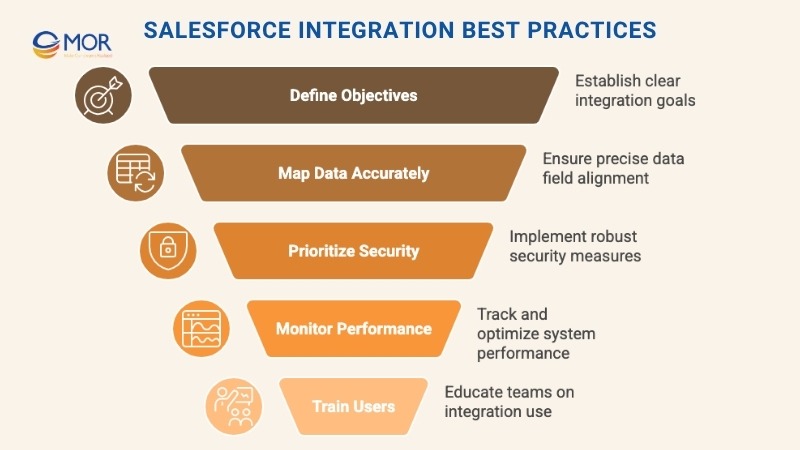
Best Practices for Successful Salesforce Integration
Key Challenges in Salesforce Integration (and How to Solve Them)
Even a well-planned salesforce integration can run into bumps. Most of these aren’t technical flaws. They’re planning oversights. Knowing what to expect helps you stay ahead and avoid slowdowns.
Data mapping issues
Different systems speak different ‘languages’. One tool may use “First Name” while another stores “Given Name.” If mappings aren’t aligned, your records will duplicate, break, or go missing.
Solving this means creating a field-by-field map before connecting anything. Define formats, transformation rules, and fallback logic. Most salesforce integration tools support this, but it still needs human review. Get it right up front.
API limits and bottlenecks
Salesforce enforces API call limits based on your plan. If your sync sends too many requests, you’ll hit that wall and your system may grind to a halt.
Avoid this by batching requests, using Bulk API where needed, or spacing updates through scheduling. Monitor usage through Salesforce’s dashboards or alerting tools. For high-volume orgs, buying more capacity or offloading some tasks to middleware often helps.
Architectural complexity
Connecting Salesforce to one app is easy. Connecting it to 12, with some on-prem and others in the cloud? That gets tricky fast.
Many teams try point-to-point links, but this creates a spiderweb of fragile connections. It’s better to use a hub-and-spoke model with a centralized integration platform. That way, changes only need to happen in one place, not everywhere.
Solutions and tools to make it easier
You don’t have to build everything from scratch. Use these tools to solve common pain points:
- Salesforce Connect: For live access to external data, without duplication
- AppExchange: For trusted, ready-made integrations
- MuleSoft or Boomi: For managing complex multi-system flows
- Estuary or Informatica: For real-time or batch ETL/ELT needs
- Salesforce monitoring tools: To track performance and usage
Many salesforce integrators rely on this stack to reduce manual effort, improve reliability, and cut down maintenance costs.
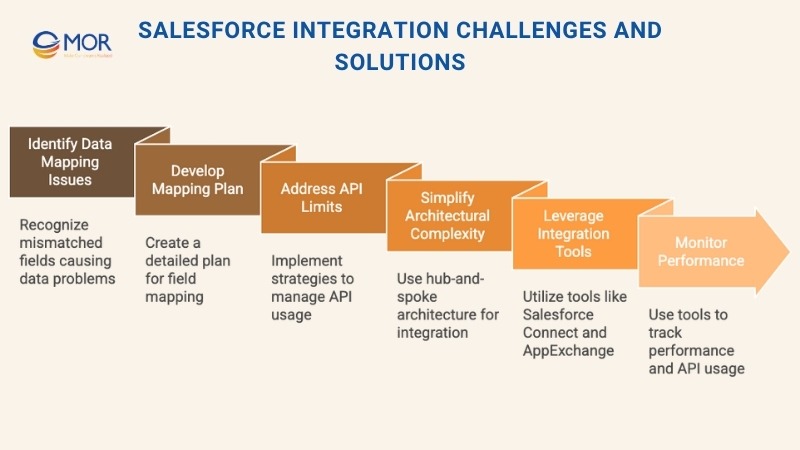
Key Challenges in Salesforce Integration (and How to Solve Them)
Conclusion
Done right, salesforce integration doesn’t just connect tools. It connects people, data, and results. From cleaner workflows to sharper decisions, the value compounds across your entire business. Whether you need to automate sales, sync with a data warehouse, or tie in customer support, there’s a method that fits. And when you're ready to move fast, it helps to work with experts who’ve done it before.
This guide from MOR Software laid out everything you need to get started. Now it’s your turn to make it real. Contact us to plan your next integration, or explore our Salesforce solutions to see what’s possible.
Rate this article
0
over 5.0 based on 0 reviews
Your rating on this news:
Name
*Email
*Write your comment
*Send your comment
1